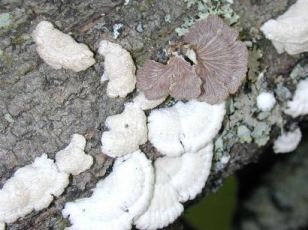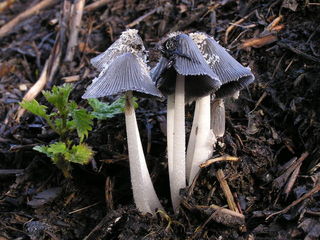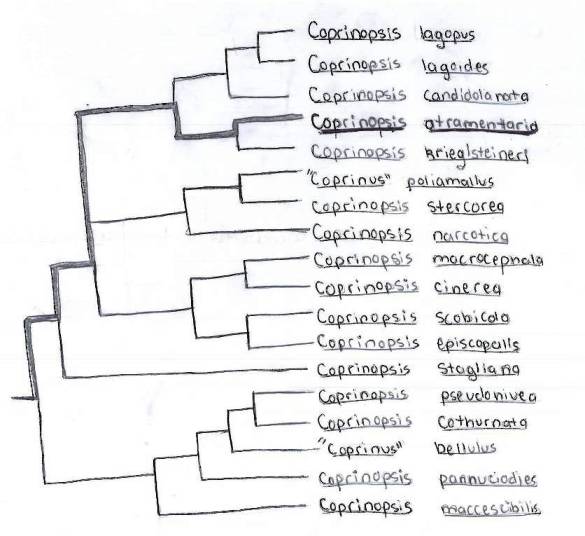Classification
 Domain:
Eukarya
Domain:
Eukarya
Kingdom: Fungi
Phylum: Basidiomycota
Class: Basidiomycetes
Order: Agaricales
Family: Psathyrellaceae
Genus: Coprinopsis
Species: Coprinopsis atramentaria
Also known as: Ink caps, Inky caps, or Tippler's Bane
Coprinopsis means "like Coprinus" and was derived from the former genus Coprinus which literally means "living on dung." Atramentaria is derived from the Latin word "atramentum" which means a very dark or black substance. This refers to the unique characteristic of the mushroom going inky.

The Domain Eukarya is mainly characterized by either single-celled or multi-celled organisms that contain membrane bound organelles and a true nucleus. In other words all living organisms accept bacteria and archaebacteria. A Kuala bear is a great example of a common Eukaryote.
The Kingdom Fungi is pretty straight forward, it contains all fungi. These organisms are characterized as being generally sessile, heterotrophic, and either multicellular like fungi, or unicellular like yeast. They also contain chitin in their cell walls.
The Phylum Basidiomycota, one of the
five major fungi phyla, contains the oh-so-familiar
mushrooms, but
also contains
puffballs, brackets, polyspores,
like
Ganoderma lucidum, jelly
fungi, and microscopic
fungi as well. The fungi in this phyla are
very diverse and there really isn't a distinct morphological
characteristic that describes them. However
all of these organisms do produce basidia (singluar:
basidium), which are cells in groups of four that
produce sexual pores (existing on gills if present).
Their lifecycles are also dominated by a dikaryon
stage, meaning that there are two haploid nuclei per
cell. The lifecycle of this mushroom is
detailed in
Reproduction.
The Class Basidiomycetes includes orders like Agricales, Lycoperdales, Nidulariales, Dacrymycetales and Tremellales. All mushroom have basidiocarp, (the structures that house the basidia), i.e. gilled mushrooms, polyspores, and boletes. Another mushroom under this class is Schizophyllum commune (illustrated to the left).
The Order Agricales is specific to the famous gilled mushrooms. These mushrooms typically contain a stalk (stipe), a pileus (cap), and lamellae (gills). The gills increase surface areas to produce and ultimately disperse more spores. A different interesting mushroom under the order Agricales is Pleurotus ostreatus.
The Family Psathyrellaceae contains the genera Psathyrella, Coprinopsis, Coprinellus, and Parasola. They are generally dark-spored agarics with somewhat soft and fragile fruiting bodies, and can have spore prints ranging from the common black to dark-brown, to the rare red print, to even pastel colors.
 The Genus Coprinopsis includes species
like lagopdies, cinereus, variegata and of coarse
atramentaria. Almost all species in this genus
are known for the extremely odd behavior of autodigestion (deliquescence). To learn more
about this intriguing term, please visit the
Going Inky section.
The Genus Coprinopsis includes species
like lagopdies, cinereus, variegata and of coarse
atramentaria. Almost all species in this genus
are known for the extremely odd behavior of autodigestion (deliquescence). To learn more
about this intriguing term, please visit the
Going Inky section.
The Species atramentaria is relatively newly formed. It was formerly classified under the genus Coprinus, however John Hopple conducted some genetic research in Rytas Vilgalys' lab at Duke University and discovered that the "coprins" actually fall into four different groups! This discovery wasn't accepted in the scientific community until many years later. How can mushrooms that share such a distinct characteristic, not be related at all!? But they do indeed belong to different genera, and even different families. Coprinus comatus was decided as the type species, making the genus Coprinus more narrowly defined. It now only includes 3 species: Coprinus comatus, C. spadiceosporus, and C. sterquilinus. To confuse things even more, molecular data proves that C. comatus belongs in the family Agaricaceae, not Coprinaceae! Now the two families are synonyms of each, thus still appropriate. The other three genera (Coprinopsis, Coprinellus, and Parasola) were then placed into the family Psathyrellaceae: Coprinopsis meaning "like Coprins", Coprinellus meaning "little Coprins", and Parasola meaning "parasola (shaped)".

The phylogenic tree to the left illustrates the Domain, Kingdom, Phylum, and Class of Coprinopsis atramentaria respectively. Kingdom Protista is actually multiple Kingdoms (still under study) that are grouped as "Protists" for convenience.
**Keep in mind that the classification of fungi is a dynamic process and is always being tested, studied and revised. To learn more about the Coprins, visit Tom Volk's Fungi Website, specifically his fungi of the month for May 2004.
 Specimens
were selected to represent all major morphologically
distinct groups of Psathyrellacea.
Specimens
were selected to represent all major morphologically
distinct groups of Psathyrellacea.
Along with Lacrymaria, specimens from three large
coprinoid lineages (Coprinellus, Parasola,
Coprinopsis) plus “Coprinus” patouillardii (=C.
cordisporus) were recognized by
Kits van Waveren (1985), thus included, as
well. Also, in a former study (Moncalvo
et al., 2002,
Padamsee et al., 2008 and Walther
et al., 2005) the genus Mythicomyces appeared to
be related to other Psathyrellaceae, and is included
as well. Altogether, 194 taxa were included in
this dada set, however for this websites' convince,
I'm only representing the Coprinopsis section.
Genomic DNA was extracted from the fruiting bodies
of each mushroom to obtained DNA sequences from
three loci, then through many series of different
statistical and analytical methods, this phylogenic
tree was devised.
Now that you know the crazy family history of Coprinopsis atramentaria, click here to find out where it lives.






